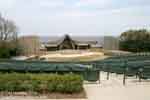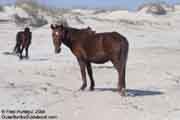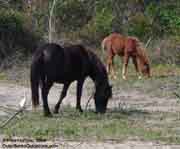 |
| The
Life-Saving Stations are tangible evidence of the influence
of the U.S. Life-Saving Service, and later the U.S. Coast
Guard, on the history of the Outer Banks. But none of
it would have been possible without the people, the men
who performed heroic, and sometimes super-human feats
to save sailors and passengers from certain death. These
are the true legends, and their stories are the true fabric
that makes the folklore of this place so special. |
Two Tales of Bravery from the U.S. Life-Saving Service
| |
A
barkentine of the era
Library of Congress (LC-D4-5568,
Detroit Publishing Co. Photograph Collection) |
December 22, 1884, the barkentine Ephraim Williams
(gleaned from a U.S.
Coast Guard narrative)
The Ephraim
Williams out of Providence, RI, had become waterlogged and
damaged in heavy weather on Dec.18, 1884, north of Frying Pan
Shoals off Cape Fear. She drifted helplessly north until Dec.
21, when she tried to anchor near Cape Hatteras to avoid drifting
into the shoals. The ship's anchor dragged until near dark,
when it finally caught bottom. Though she had been spotted by
three stations - Cape Hatteras, Creed's Hill and Durant's, conditions
were too bad for a surfboat. The ship was not sinking, and had
not signaled for help, so the three stations, along with the
Big Kinnakeet crew kept vigil all that night, still with no
signs from the ship. At daybreak on the 22nd they discovered
the ship had drifted northward to near Big Kinnakeet station.
In spite of a sleepless night of vigil they prepared for a rescue
should the ship send signal.
About 10:30
a.m. the ship ran up a signal flag, and the Cape Hatteras station
crew, assisted by Keeper Etheridge from Creed's Hill station,
set out in their surfboat, with only cork belts and their own
grit to save them from drowning should their surfboat capsize.
The other crews knew it was hopeless, sure the surfboat could
not make it over the treacherous outer sandbar with the sea
conditions that existed that day. But luck and skill prevailed,
and the small boat somehow made it across. Still they had several
miles to row to reach the ship. Encouraged by the success of
the Cape Hatteras crew, the Big Kinnakeet crew set out in their
surfboat, but could not manage the crossing of the outer sandbar.
Disheartened, they could only turn back and hope the Cape Hatteras
crew could manage alone.
Two exhausting
hours later they reached the Ephraim Williams, but could
not pull along side because of the seas. By means of a rope,
they eventually managed to move close enough to rescue the ship's
crew of nine, who had been battered for over ninety hours. The
surfboat, with its sixteen cold, wet and exhausted passengers
was finally rowed back to shore. For their skill and bravery,
the crew was awarded the Gold Life-Saving medal.
The honored
Cape Hatteras crew list reads: Keeper Benjamin B. Dailey, Keeper
Patrick H. Ethridge (keeper of the Creed's Hill station, filling
in for an absent crewman), Isasc L. Jennett, Thomas Gray, John
H. Midgett, Jabez B. Jennett, and Charles Fulcher.
February 10, 1905, the three-masted schooner Sarah D.
J. Rawson
(gleaned from a U.S.
Coast Guard narrative)
When the
Sarah D. J. Rawson stranded on Lookout Shoals in a gale
on the 9th of February, 1905, she immediately began breaking
apart. Battered by waves breaking over the ship lying on her
side, the crew could only cling to the highest parts and wait,
hoping to be discovered and saved. The ocean was sheathed in
fog that day, and even though the watch at Cape Lookout Life-Saving
Station kept a keen eye to the sea, the ship was hidden from
view. As fate would have it, Keeper William H.Gaskill took the
glasses during the noon watch change, and spotted only the tip
of the spars through the thick soup, some nine miles away. Knowing
nearly from the bearing that the ship must be on the shoals,
he called up the surfmen to man the boat. Most of the crew had
been ill with the flu, but every man turned out for his duty
in the icy wet chill that would be their company for longer
than they could have imagined.
By 4:00
p.m. the rescuers reached the wreckage, and found the ship ringed
with debris. Parts of the ship and its deck-cargo of lumber
lunged and crashed all about it on the waves like a gauntlet
of battering rams. The surfboat could not get near enough to
be of any use, or to even heave a line. They could do nothing
as darkness set in, so they anchored the surfboat and kept vigil,
in hopes they could pull survivors from the sea should the ship
come completely apart in the night. They fended off ship's debris
that threatened to batter their surfboat, but kept station.
The weather worsened about midnight, and turned colder. Though
wet, cold, hungry and exhausted, the crew waited out the night
tossed about in the raging storm in the little surfboat.
At daybreak
of the 10th they could see the ship's crew still clinging to
their pitiful wreckage. But the seas had not subsided, and they
still could not get close enough to affect a rescue. Keeper
Gaskill determined to wait for the tide to change, hoping to
find a better sea. His judgment proved right, and they were
finally able to skillfully dodge the flotsam to get within range
to throw a line to the wreck. One by one the survivors were
pulled through the sea to the lifeboat at the end of a rope.
In spite of vicious winter wind, being ill and soaked to the
bone, and without food or rest for some 28 hours in an open
boat, the unflinching surfmen of Cape Lookout Life-Saving Station
successfully saved the six crewmen of that doomed ship.
The honored
crew receiving the Gold Life-Saving Medal for this rescue were:
Keeper William H. Gaskill, Kilby Guthrie, Walter M. Yeomans,
Joseph L. Lewis, John E. Kirkman, Tyre Moore, John A. Guthrie,
Calupt T. Jarvis, and James W. Fulcher.
Other Tales of the Sea and Sand
These were but two of the many enthralling
tales of true courage played out by the brave men of the U.S.
Life-Saving Service, and later, the U.S. Coast Guard life-saving
stations. But these were not the only stories that came from
the dire consequences of tangling with the "Graveyard of the
Atlantic", or with piratical crews.
Take for instance the tale of the flaming
ship of Ocracoke, as relayed in the book of the same name by
Charles Harry Whedbee. The tale is set more than two hundred
years past, when Portsmouth Village on Core Banks was a thriving
town across Ocracoke Inlet from the current Ocracoke Village,
which was in that day known as Pilot Town. This inlet was then
the main passage for sailing ships entering the sounds of North
Carolina to reach the mainland river ports.
As the tale goes, a shipload of immigrants
arrived from Europe, and their ship anchored outside the inlet
so the tired passengers could come ashore at Portsmouth Village
for the day. Later they were to transfer to smaller vessels
for their trip inland to their destination ports. Fearful of
leaving their valuables aboard ship unguarded, they chose to
bring them along. But when the captain saw what they carried
as they waited on deck to board the shore boats, his larcenous
nature took the better of him. He quickly hatched a plan with
his mates and told the passengers there was a problem and they
would have to wait until the next day to go ashore.
That night, which happened to be the first
new moon in September, the crew murdered every passenger, ransacked
their belongings, and stole all their valuables. Then they set
the ships sails, turned her out to sea, and set the deck afire
to add credence to their woeful tale of disaster aboard ship
to cover their crime. But as the captain and crew fled to shore
in their longboat, they were aghast to discover the ship had
turned and was bearing down on them at full speed amidst mournful
wails coming from below decks. Their efforts to flee failed,
and they and their boat were rolled beneath the ships keel.
Then it is told the crewless ship turned and sailed back out
to sea, sails still aflame, and eerie voices still crying out
from the ships hold.
To this day it is said that every September,
with the new moon, the ghost ship returns to make its flaming
run outside Ocracoke Inlet. Thus goes but one of the tales you
can find and read about based on the folklore of the Outer Banks.
Some
books by Charles H. Whedbee
- The
Flaming Ship of Ocracoke and Other Tales of the Outer
Banks
-
Blackbeard's Cup and Stories of the Outer Banks
-
Legends of the Outer Banks and Tar Heel Tidewater
-
Outer Banks Tales to Remember
|
Indeed there are many tales told about
the Outer Banks, and not all of them ghostly in nature. There
are tales of great fish, and tales of lost love, and a bit of
everything in between. The Outer Banks certainly has more than
its share. Where did the name "Jockey's Ridge" originate, or
the name "Nag's Head"? What is the true origin of the wild ponies
along the Outer Banks? How did the "Mother Vineyard" of Roanoke
Island get its name?
The Lost Colony and Fort Raleigh
  One of the most researched, yet still
unanswered mysteries from the beginnings of written history
of the Outer Banks begs to this very day for an answer. What
happened to the "Lost Colony" of settlers on Roanoke Island?
The Fort Raleigh National Historic Site is located on the northern
tip of Roanoke Island. The site features what is said to be
the remains of the earthen
fortification used by the doomed colonists.
One of the most researched, yet still
unanswered mysteries from the beginnings of written history
of the Outer Banks begs to this very day for an answer. What
happened to the "Lost Colony" of settlers on Roanoke Island?
The Fort Raleigh National Historic Site is located on the northern
tip of Roanoke Island. The site features what is said to be
the remains of the earthen
fortification used by the doomed colonists.
 Adjacent to the site is the Lost Colony
Outdoor Drama amphitheater.
Jockey's Ridge is visible across the sound from the amphitheater,
and from any place along the shore which can be reached through
the trees at the Fort Raleigh site. One might wonder what the
colonists though of the huge sand dune across the water from
the lush green island where they were attempting to make a new
settlement. Were they curious about it? Did they take a canoe
or rowboat across to see it? We will likely never know.
Adjacent to the site is the Lost Colony
Outdoor Drama amphitheater.
Jockey's Ridge is visible across the sound from the amphitheater,
and from any place along the shore which can be reached through
the trees at the Fort Raleigh site. One might wonder what the
colonists though of the huge sand dune across the water from
the lush green island where they were attempting to make a new
settlement. Were they curious about it? Did they take a canoe
or rowboat across to see it? We will likely never know.
 Wild Horses of the Outer Banks
Wild Horses of the Outer Banks

Wild horses have always been a part of
the Outer Banks and its folklore. At one time there were thousands
of wild horses roaming freely all along the Outer Banks, from
Shackleford Banks and Core Banks all the way up to Currituck
Banks. In the 18th and 19th centuries, and on into the early
and mid 20th century, those who lived on the Outer Banks often
rounded up these wild horses and tamed or sold them. One legend
says that Jockey's Ridge was named such because people used
the sand dune as a vantage point to watch horse races which
circled the dune.

Another legend says the name Nags Head
supposedly came from scoundrels that in the 1700's would tie
a lantern to a horses neck and walk it up and down the beach
at night. Merchant ships would mistake the light as coming from
another ship and change course toward it, unwittingly running
aground and providing "pirated" cargo, or perhaps "salvaged"
cargo, depending upon your perspective. Sometimes the lifesaving
station beach patrols would ride horses on their watch rounds.
In the 1950's, Ocracoke had the first mounted Boy Scout Troop
in the country. They rode tamed "Ocracoke Ponies",
as the wild horses on Ocracoke were popularly called.
The horses themselves are believed to
be descended from Spanish mustangs which swam ashore when early
Spanish explorers shipwrecked, or had to abandon their cargo
and release their animals in order to repair damaged ships.
This very scenario is part of a tale which says that Sir Richard
Grenville, on a supply expedition for the "Lost Colony"
at Roanoke Island, ran aground near Ocracoke, and may have released
livestock he was carrying for the colony, including Spanish
horses, in order to facilitate repairs. There were hundreds
of opportunities for this to happen all along the "Graveyard
of the Atlantic" for at least 400 years.
For more about these wild horses, which
still run wild on Shackleford Banks, and north of Corolla, go
to Wild
Horses of the Outer Banks. |
|








